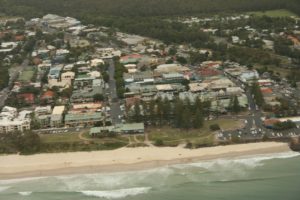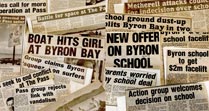The Byron Bay of 1971 when Reg and Jean Wright launched the Byron News, where I started working as editor in 1995, was vastly different to the Byron Bay of today
Back then, the Bay was a meatworks town with a close-knit population of around 2500 where just about everyone knew each other, or if they didn’t, probably knew of them.
There was Mexican Mick’s and Ryan’s Café and there was Simmo’s Golden Fleece service station where it still stands today, although with a different name.
You could buy a three-bedroom house with ocean views for $25,000, or a block of land from $2000.
It was the sort of town where the ‘Çlosed’ sign went up at lunchtime on Saturday and didn’t come down until Monday morning. A town where the same ‘Çlosed’ sign went up in some shop windows in winter because the business just wasn’t there.
A town where kids could play cricket on the roadway in Jonson Street near Railway Park and not worry about cars interfering with their game.
A town that had seen whaling come and go in a very short time and a town that still had a sandmining processing plant operating where Woolworths now stands.
Apart from surfers, who discovered the breaks in the 60s, the town wasn’t even a blip on the “gotta go there” radar.
There were holidaymakers, of course, mostly family groups who camped and summers were busy. But there certainly was no hint of the tourism explosion that was to come.
While alternative lifestylers gradually changed the flavour of Byron Bay in the 70s and raised its profile somewhat, the first of two major events – a closing and an opening – in recent history that would change the shape of the Bay forever, occurred in 1983 .
On October 28 that year, the F J Walker meatworks at Belongil Beach, the town’s biggest employer, closed its doors for the last time throwing 350 people out of work.
It sent shockwaves through the town and those of us who were here felt the anguish of the families who faced an uncertain future. And it was uncertain, because there just weren’t any other jobs.
Business owners – including myself and my wife, Pam, escapees from Sydney, who had just bought a café – also faced a shaky future.
I remember my optimism wasn’t buoyed any after being told – in colourful terms – by a neighbouring business owner who had operated in the town for many years that “this town’s f…… mate”.
Well, it wasn’t.
The closure of the meatworks was the catalyst for the town’s leaders, from Byron Council down, to determine that tourism was going to be the great saviour and set off on a course to achieve that.
It took time, but, depending on your view of big crowds, crowded surf breaks and traffic snarls, it worked a treat.
And what really kicked it on and led to Byron Bay gaining a national and international profile as a tourist destination was the second of the two major events I alluded to previously – the opening in the early 1990s of The Beach Hotel by John Cornell and his wife, Delvene Delaney.
Aided by their connection and friendship with Crocodile Dundee star, Paul ‘Hoges’ Hogan, the opening of the hotel got the sort of nationwide publicity money couldn’t buy.
At about the same time, the infant backpacker industry started maturing and has now reached the stage where backpackers are a very visible and dominant visitor group.
The same period saw major growth in the entertainment field with the Backroom regularly hosting top-flight acts and the East |Coast Blues and Roots Festival and Splendour in the Grass boasting line-ups the envy of capital city gigs and gaining international reputations in the process.
The opening of the Chinderah to Yelgun freeway some years ago saw an explosion of day-tripper visits from south-east Queensland. And the border came even ‘çloser’ when the freeway to the gates of Byron Bay and beyond was completed.
Today, Byron Bay is one of Australia’s major tourist destinations attracting close to two million visitors a year and, including Suffolk Park and Ewingsdale, has a permanent population of around 10,000.
No-one has to be told that house prices also have come a long way from the $25,000 of 1971, with the average house price hovering around the million dollar mark.
